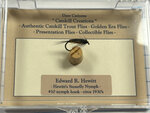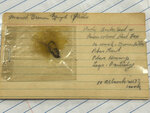Summer’s heat continues to keep many trout fishers indoors to give the trout a respite. On Sunday afternoon, July 21, 2024, the Beaverkill at Cooks Falls was flowing at 143 cubic feet per …
This item is available in full to subscribers.
Please log in to continue |





Summer’s heat continues to keep many trout fishers indoors to give the trout a respite. On Sunday afternoon, July 21, 2024, the Beaverkill at Cooks Falls was flowing at 143 cubic feet per second, which is below the median average flow on this date of 157 cfs over 110 years of record-keeping, despite some heavy rainstorms over the past several days.
However, temperature remains a problem, as the river spiked to near or above 80 degrees F over much of the past week.
Dette Flies, in Livingston Manor, is capitalizing on keeping thoughts on trout and trout fishing while keeping trout anglers off the warm and low water with a series of special programs offered free of charge.
On Saturday, July 20, an informative program titled The Dette Nymphs, A Historical Discussion was hosted by Seth Cavarretta and featured an in-depth conversation with Dave Catizone. A known fly-tyer and collector of historical flies and artifacts, Dave captured the audience of about 20 with his memories and experiences with some of the greatest Catskill fly tyers of all time.
Beginning his talk with mention of how American flies evolved from the English flies used prior to the turn of the century, Dave talked about Theodore Gordon, known as the “Father of American Dry Fly Fishing” and how he moved to this area and stayed at various inns and boarding houses along the Neversink, Beaverkill, and Willowemoc, while keeping up correspondence with some of the great English fly-tyers of that period.
He described how, in 1890, Gordon began corresponding with Fredric Halford of England. Halford sent letters and packages of flies that were delivered to Gordon by the postman from Liberty, Roy Steenrod. Gordon became friendly with Steenrod, and taught the young man how to tie flies. Steenrod eventually became one of the originators of the Catskill School of Fly Tyers.
Following a timeline, Seth asked Dave to discuss the early nymphs that were tied by original Catskill School members, including Harry and Elsie Darbee and Walt and Winnie Dette. In the early 1930s, the popular nymph patterns were the Hare’s Ear Nymph, Prince Nymph, and March Brown Nymph. They were generally tied with dark colors and were hard-bodied. Dave had several boxes of these historic flies, labeled by each tyer, that he passed around for all to see, including flies tied by Edward R. Hewitt.
It was fascinating to see some of the hard-bodied lacquered flies tied by Hewitt, in contrast to the softer ‘fuzzy’ flies, such as the Hare’s Ear Nymph that the Darbees and the Dettes began to transition to.
Seth asked why the transition occurred, and Dave posed his thoughts: material availability (some of the materials were hard to get) as well as the fact that soft dubbing, as was used on dry flies, was easier and quicker to tie on than going through the process of lacquering the bodies as Hewitt did. And the Darbees and the Dettes became so involved with dry flies, they whittled down their nymph offerings to only a few, including the softer-bodied nymphs.
In order to keep up with demand, both couples were producing hundreds of thousands of commercial flies, and needed to focus on speed of production.
The Darbees’ house was a gathering place for anglers and fly-tyers, local folks as well as visitors from New York City and all across the country.
Dave described how the Darbees, the Dettes, and Art Flick (from the West Kill) discussed and shared ideas on tying materials and patterns. Dave passed around three March Brown nymphs, as tied by Edward R. Hewitt, Elsie Darbee and Walt Dette - that looked completely different from each other.
By the 1950s, there were some post-war changes in fly-tying. Hooks had been scarce but fly-tyers were now able to find feathers and materials easier to come by.
As time went on, by the 1960s, the feather merchants began to arrive from New York City. As more exotic materials became available, such as jungle cock feathers used by John Atherton for ‘eyes’ on his flies, and large feathers used by milliners for women’s hats, different styles of flies became popular.
Dave mentioned Poul Jorgensen, the world-famous Salmon fly tyer, who was living in Michigan in the 1960s. He befriended Bill Blades, also of Michigan, and one day saw a collection of realistic flies in the trunk of Blades’ car. Blades showed Jorgensen how to tie these realistic nymphs.
Poul moved to Roscoe in the 1970s, and convinced a young Dave Catizone to do as well. Dave credits Poul with introducing him to many of the well-known tyers in the area.
Dave related how fortunate he was to have “met a lot of people in my life - they were nice to me, people who took me in”. He credits Elsie Darbee with teaching him how to tie flies in her style - and mentioned that he would start off only tying tails, then ribbing, then wings - and finally, after nine months, a complete fly!
As time went on, nymph flies underwent another transformation, to the gold bead heads and weighted patterns so popular today, that provided the ability to carry the fly down toward the bottom of the stream and started to replace the use of split shot. And by the mid 1980s, caddis flies “really took off” and became popular flies to use and tie.
The session ended with a question and answer period and a chance for attendees to come up to view Dave’s collection of historic flies.
The Dette Flies Saturday Series continues on Saturday, August 3, with a program on “Dry Fly Hackle 101” with “Catskill” John Bonasera.
Comments
No comments on this item Please log in to comment by clicking here